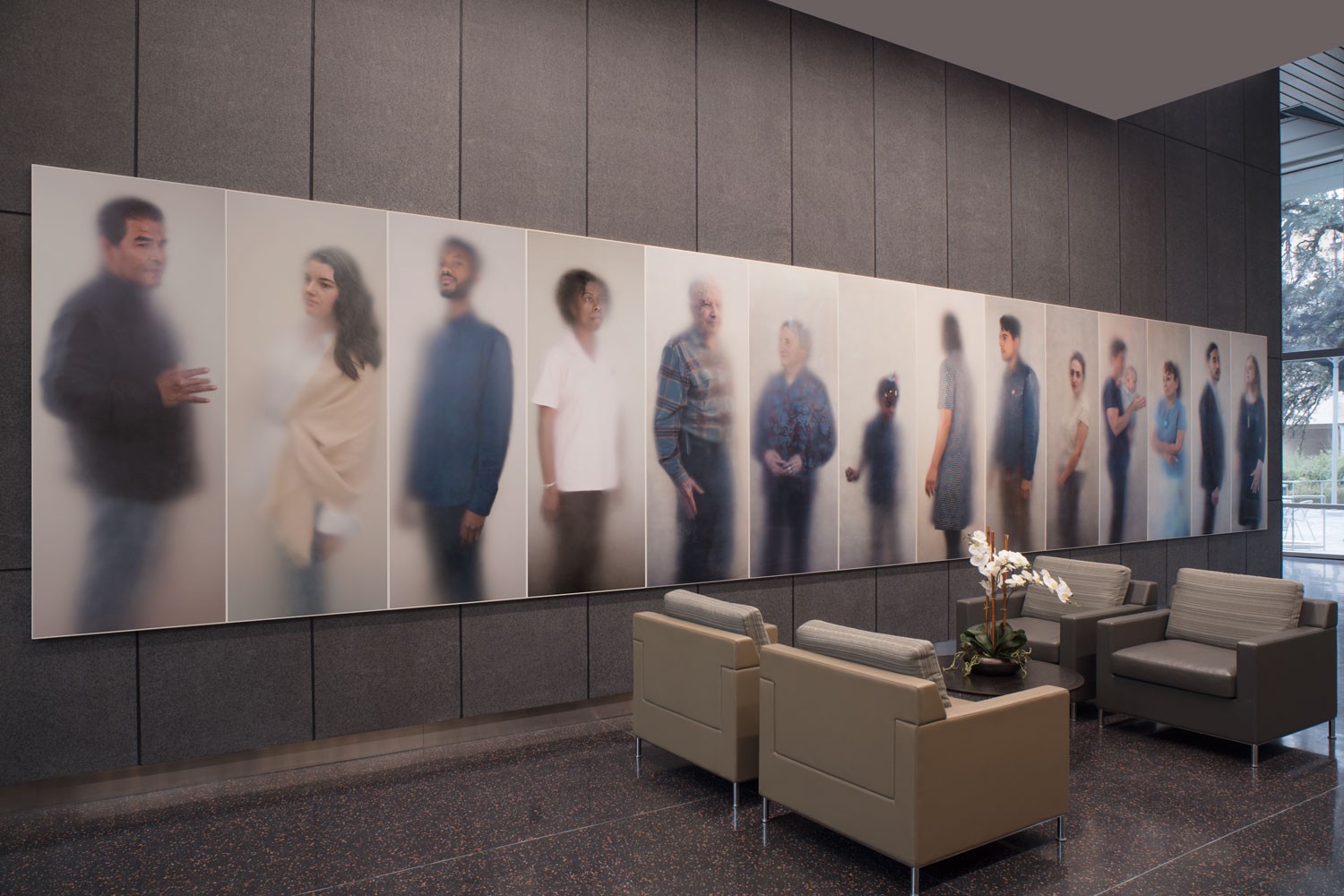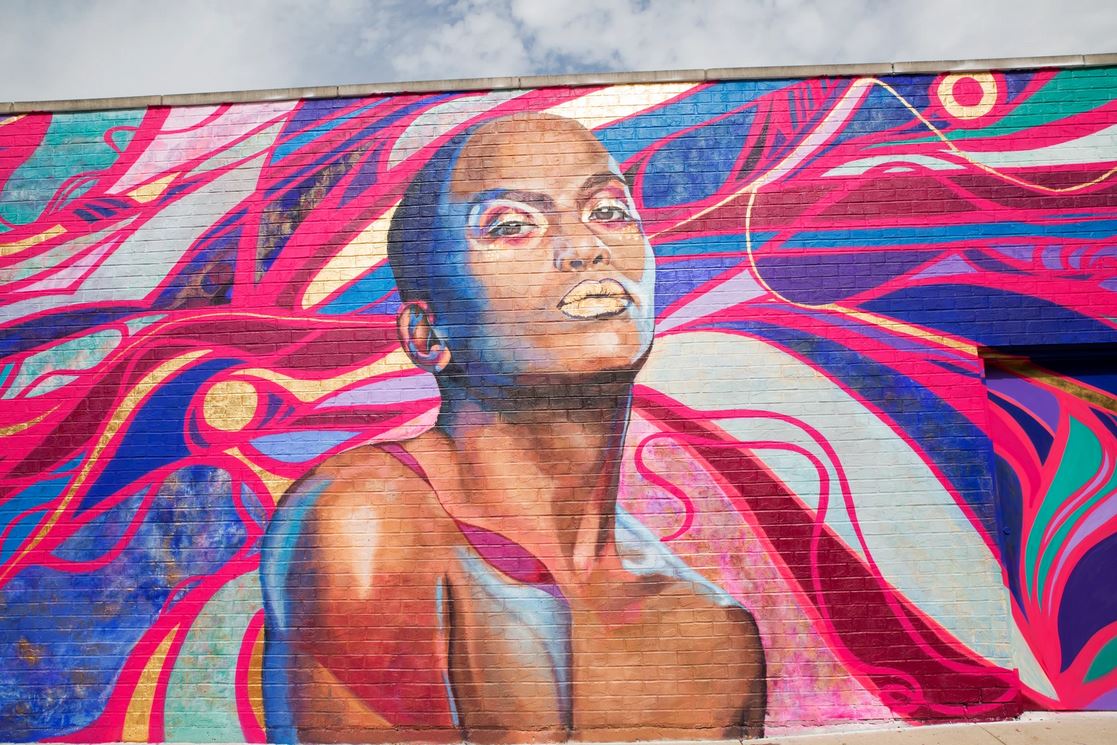Blog by Alice Wang BS, Sidharth Chand BA, Hyewon Hyun MD, Megan Carleton ATR-BC, Daniel B Chonde MD-PhD

Introduction
Marginalized communities, especially communities of color frequently feel isolated and excluded from the healthcare system. A clear history of neglect, mistreatment, and experimentation has engendered mistrust of health providers and medical institutions. As entrenched inequities in healthcare continue to be recognized and addressed, the art in medical spaces presents as an overlooked opportunity.
While the therapeutic benefits of making art or the use of art in medical training have been well explored – for instance art therapy to improve patient well-being and art observation to improve medical diagnostic skills – less attention has been given to the art that hangs on the walls of medical spaces. The prevailing methodology, supportive design1, emphasizes that art can provide a sense of control, positive distractions from illness, and social support by tapping into each patients’ individual, social, and cultural histories. This framework has been validated in numerous example studies2,3. By engaging patients as individuals with distinct sociocultural identifies, curated waiting room art has the potential to create inclusive and safe clinical environments. However, there is minimal discussion on this topic, especially how art affects the patient experience for underserved individuals.
The colorblind waiting room

Despite its potential for inclusivity and representation, common implementation of supportive design in US clinical spaces often defaults to a colorblind aesthetic3,4. Nature and landscapes, subdued themed photographs, and abstract paintings predominate in clinical spaces, conveying tranquility and healing while avoiding references to race, culture, language, and sexuality. Art in medical spaces is akin to muzak, the unobstrusive music played in elevators and department stores; it typically fosters an inoffensive, colorblind aesthetic. The issue is these images and pieces of artwork implicitly rely on Eurocentric symbolism, failing to depict social and cultural realities for diverse patient populations. Thus, underserved individuals can experience colorblind imagery as exclusionary or alienating.
Equity not equality—Creating welcoming spaces
This colorblind aesthetic, derived from the theory of supportive design, reflects an intention to create equality: equal access to all people regardless of gender identity, race, religion, and sexual orientation. Despite this intention for inclusivity, the need for equitable representation is not addressed. Inclusive design, in contrast with supportive design and with colorblind aesthetics, emphasizes equitable representation. By visually depicting figures and symbols that resonate with minority populations, these visuals include their experiences. Equity in waiting room art means choosing to represent the forms and figures that typically go unseen or are overlooked – for instance images of aloe plants and portraits of people of color – which signal to minority populations that their sociocultural histories are acknowledged, included, and welcomed.

Research has shown that effective use of representative imagery and symbolism from specific groups serves to establish alliance and improve patient trust. A multicenter study on caring for of LGBTQA youth found that displaying visual symbols of support like the pride rainbow helped queer youth identify spaces in which and people with whom they felt safe to disclose their identities5. Symbols specifically representing underserved populations are “informational shortcut[s]” that provide meaningful prefaces for clinical encounters. These visual cues can be present both inside and sometimes literally outside of clinical spaces, as in the mural The Love I Vibrate recently painted on the outer wall of the Howard Brown Health Center in the Boystown neighborhood of Chicago. This stunning work serves a dual purpose: ornamentation and representation. Its location on the outer façade. Such visual cues will create a sense of care and safety for these patients, helping to establish rapport and gradually build trust within the healthcare system. These findings support symbolism in waiting room art as a means of representation for diverse patient populations and their sociocultural histories.
We can learn from international health systems that have recognized the sociopolitical power held by hospitals and medical spaces. By integrating representative art, telling stores of the past while finding direction for the future, these institutions align themselves with the patients they serve. The longstanding tradition of murals within Mexican hospitals, which almost act as large-scale waiting room art, are a compelling illustration of art in clinical spaces that connects with social reality. These murals depict an abundance of figures and scenes reflecting “death, struggle, disease, and social injustices,” transforming the hospitals they decorate into “distinctly Mexican urban objects”6. These artworks contrast against the typical idealized and neutralized representations commonly seen in hospitals and instead underline a hospital’s connection to the society in which it exists. The usual United States medical space, by employing a colorblind aesthetic, fails to take ownership for injustices experienced by minority patients, forfeiting the potential to remedy historical wrongdoings and build alliances for the future.
Certain hospitals in the United States are no stranger to sponsorship and installation of artwork and exemplify themes of inclusion and representation in some of their curations. A particularly salient example is set by NYC Health + Hospitals, the public enterprise charged with administering city hospitals and clinics that also houses the largest public art collection in New York City. Among the thousands of artworks on display, large murals in common spaces and waiting areas stand out. Man Emerging is one such piece in the foyer of the Harlem Hospital Center created by Charles Aston in 1963 during the height of the Civil Rights Movement in the United States. The posing of a diverse throng marching together with heads lifted upwards eyeing the future emphasizes themes of togetherness and progress that uniquely resonate with the Black experience of the time. The location of this artwork in Harlem, a storied neighborhood and origin of its namesake renaissance, cements the hospital as an institution in service of the people who live around it. Other medical spaces elsewhere in the United States can learn from this example of inclusion and representation catalyzed by art on public display.
Inclusive design means fostering authentic representation through visual representation. We advocate for the inclusion of themes, symbols, and images meaningful to and representative of minority individuals in waiting room art. It is important to support the work of minority artists while also accounting for the experience of the viewer. There is a temptation to showcase works of art that align with the colorblind aesthetic and coincidentally are created by minority artists. Supporting minority artists is undeniably important; however this practice tokenizes the artist’s identity and can feel culturally exploitative. As we consider the experience of the viewer, these colorblind works art – albeit beautiful – do not optimally connect with or represent the viewer’s identity. Unlike in a museum, waiting room art is not typically accompanied by information about the artist, limiting the extent to which viewers can connect with the artist’s identity; a minority viewer has no way of knowing that the art was created by a minority artist. At the heart of inclusive design is authentic visual representation of symbols that resonate with minority viewers and genuine support for minority artists, both of which should be integrated into medical spaces.
While inoffensive, the colorblind aesthetic of art in medical spaces fails to connect with the social, cultural, and historical diversity of the individuals viewing the art. A transition toward inclusive design through thoughtful integration of symbolism and representation can help patients feel seen, bolster alliances between minority populations and their care providers, and support the overall need to address inequity in the healthcare system. Curation of artwork for medical spaces should depicts themes, symbols, and figures that resonate with and represent minority individuals. Authentic representation, alongside with wholehearted support for minority artists, can allow us to realize the full potential waiting room art has in enhancing the patient experience and addressing health inequity.
References
- Ulrich, R., & Gilpin, L. (2003). Healing arts – Nutrition for the soul. In S. B. Frampton, L. Gilpin, & P. A. Charmel (Eds.), Putting patients first: Designing and practicing patient-centered care (pp. 117–146). San Francisco, CA: Jossey-Bass – A Wiley Imprint.
- Lankston, Louise, et al. “Visual art in hospitals: case studies and review of the evidence.” Journal of the Royal Society of Medicine 103.12 (2010): 490-499.
- Andrade, Cláudia Campos, and Ann Sloan Devlin. “Stress reduction in the hospital room: Applying Ulrich’s theory of supportive design.” Journal of Environmental Psychology 41 (2015): 125-134.
- Hanson, Hazel, et al. “Preferences for photographic art among hospitalized patients with cancer.” Oncology nursing forum. Vol. 40. No. 4. Oncology Nursing Society, 2013.
- Wolowic, J. M., Heston, L. V., Saewyc, E. M., Porta, C., & Eisenberg, M. E. (2017). Chasing the rainbow: Lesbian, gay, bisexual, transgender and queer youth and pride semiotics. Culture, Health & Sexuality, 19(5), 557–571. https://doi.org/10.1080/13691058.2016.1251613
- Soto Laveaga, G. (2015). Building the nation of the future, one waiting room at a time: Hospital murals in the making of modern Mexico. History and Technology, 31(3), 275–294. https://doi.org/10.1080/07341512.2015.1130290
Alice Wang is a medical student at Harvard Medical School in the Harvard-MIT Health Sciences and Technology Program. She is passionate about integrating the arts to enhance the practice of clinical medicine.
Twitter: @alice_wang3
Website: alicewang.weebly.com
Sidharth Chand, MS is a student at Harvard Medical School. He is interested in the intersection of arts and medicine to create welcoming spaces for diverse patient populations.
Twitter: @SidharthChand6
Megan Carleton, , LMHC, ATR-BC is a board certified art therapist and licensed mental health counselor. She is the artistic director for The Peoples’ heART.
Website: www.thepeoplesheart.org
Hyewon Hyun, MD is the founding Chair of Diversity, Equity and Inclusion Task Force of the Society of Nuclear Medicine and Molecular Imaging. She has developed and launched novel educational curricula in collaboration with art educators at the Harvard Art Museums for radiology and nuclear medicine residents as well as for under-represented high school, college and first-year medical school students who seek to pursue STEM careers.
Website: www.thepeoplesheart.org
Dan B Chonde, MD PhD is the diversity, equity, and inclusion chair of the American Roentgen Ray Society and involved in a number of other healthcare related diversity initiatives. He is the executive director for The Peoples’ heART.
Twitter: @DanChondeMD
Website: www.thepeoplesheart.org